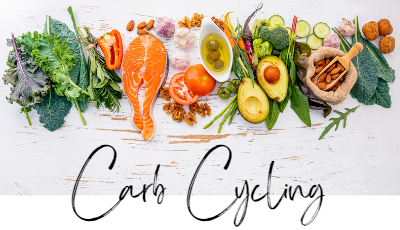Carb cycling is definitely not the secret to weight loss. But it can be a great strategy to help you lose weight.
What is carb cycling?
Carb cycling is a dietary approach where you strategically increase or decrease your carb intake during a predetermined time frame. Common carb cycling approaches are low/high and low/medium/high carb intakes. Carb cycling may be a useful strategy to optimize your diet, improve physical performance and health, or to allow for more flexibility with your diet. Carb cycling strategies can be implemented in days, weeks and even months.
There are no specific rules when it comes to carb cycling and you can choose the strategy that best works for your lifestyle and your goals.
Who is carb cycling for
Carb cycling is an advanced dieting approach that takes a little more work than following the same carbs and calories daily but can be accomplished with a little more planning. Carb cycling is not just for weight loss. You can use carb cycling as a strategy for managing your nutrition no matter if you want to
- Lose weight
- Maintain weight or
- Build Muscle
| ⚠️ Carb cycling may not be advisable for you if you are just beginning to track your nutrition due to the complexity of keeping track of which days are high carbs and which are low carbs. However, if you pre plan meals in advance and log them, then this might be a great approach for you to try. Important note: No matter how you utilize carb cycling, your total calorie intake for the week should remain the same as if you’re not carb cycling. Maintaining your calorie intake allows for you to continue working on your goals. |
Carb Cycling Days
If you have heard of carb cycling before, you have probably always heard about it in terms of days per week. Carb cycling has been utilized by athletes for different types of sports for years. Endurance athletes vary their carbohydrate intake to fuel their training sessions and their big events. Aligning your nutrition with your performance goals can help you to achieve your best athletic capabilities.
Likewise a competitive bodybuilder might use carb cycling strategies during prep to manage hunger, energy levels and performance in training sessions and during peak week to look their best on show day.
But carb cycling has many different applications. Here are just a few examples:
- Endurance athletes to optimize athletic performance
- Fuel for the work required: Higher calories on training days and lower calories on rest days
- Eating differently during the week vs the weekend
- Flexibility for social occasions
- Refeeds for bodybuilding competitive athletes
- Women to manage menstruation cycles
While the focus is generally on the manipulation of carb intake, you may also adjust protein and fats. For example: On a high carb day you might reduce your protein or fats by 5 to 10 grams. Likewise, on a low carb day you might increase your protein or fat intake to help manage hunger. Often you keep your protein the same and just adjust your carbs and fats.
When I am in prep to compete for my bodybuilding shows there are periods of time when I may lower my carbs to prepare my body for a drastic increase in carbohydrates. I may cut my carb intake in half. During these few days, I will increase my protein intake by 10-15 grams to help manage hunger.
Getting Started with Carb Cycling
To get started, if you do not not already know your weight loss deficit calories, you need to determine your baseline calorie needs for your goal and your body. My Weight Loss Macro Calculator can be used to find your starting macro and calorie intake for weight loss. If your goal is not weight loss, I recommend using the TDEE Calculator.
For example, let’s say the calculator helps you determine that for your weight loss goal, you need a daily intake of: Protein: 135 grams, Carbs: 180 grams and Fats: 50 grams Calories 1710.
To apply these numbers to carb cycling, start by multiplying the recommended daily carb intake by 7. That’s your total carb intake for the week. Example: 180 X 7 = 1260 g carbs for the week
Based on your carb cycling strategy, you’ll adjust your carb intake for a given day. You’ll eat the same amount of carbs as you would without carb cycling, but distribute them a little differently throughout the week. (Your fat and protein intake will remain the same every day.)
Remember: Your total calorie and macronutrient intake for the week should remain the same as if you’re not cycling to ensure you are still also able to reach your goals.
This carb and calorie cycling approach is very simple and straightforward.
On low carb/calorie days, focus on mostly lean protein sources, vegetables and healthy fats with a reduced intake of carbs around 25-50 percent of your usual carb intake.
On higher carb/calorie days, focus on adding additional carbs above usual carb intake around 100 – 150 percent of your usual carb intake
Let’s see this in action.
Here is an example of a Low/ High Carb Cycling 5/2 Split
| Proteins | Carbs | Fats | Calories | Total Calories x 7 | |
| Baseline | 135 | 180 | 50 | 1710 | 11970 |
| 5 Low Days | 135 | 120 | 60 | 1560 | 7800 |
| 2 High Days | 135 | 274 | 50 | 2086 | 4172 |
| 11972 |
Here is an example of a Low/ High Carb Cycling 4/3 Split
| Proteins | Carbs | Fats | Calories | Total Calories x 7 | |
| Baseline | 135 | 180 | 50 | 1710 | 11970 |
| 4 Low Days | 135 | 120 | 50 | 1470 | 5880 |
| 3 High Days | 135 | 274 | 50 | 2030 | 6090 |
| 11970 |
The 5/2 or 4/3 split can be a great option for you if you can manage your nutrition and eat fewer calories during the week due to a more structured schedule but find it challenging on the weekends due to social situations.
Here is an example of a High/Medium/Low Carb Cycling Strategy 4/2/1
These are just a couple examples of carb cycling splits but really you can choose whatever split works best for you.
Carb Cycling within 1 Day
You might have only thought of carb cycling in terms of days in a week but you could also carb cycle within a day. You may eat more carbs around your workout sessions and less at other parts of the day.
Another way you may apply this is when you know you are going out for a carb heavy dinner like pasta then you could reduce your carb intake throughout the day and focus on more lean proteins and fats to allow for more carbs for your dinner.
Carb cycling within 1 day in action might look like this.
Most meals for the day consist of a serving of whole lean proteins, a serving of healthy fats and ¾ of your plate filled in with low calorie high volume vegetables like a salad.
The one meal that can be post workout or for a special occasion would include a serving of lean protein, a ½ serving of healthy fats and a larger portion of carbs around 50 percent or more of your daily intake.
Carb Refeeds
Another carb cycling approach is to increase carbs after a prolonged period following a low carb diet phase. This approach is called a refeed.
Here are some examples of different low carb plans with occasional high carb refeeds:
| Low carb period | High carb period | High Carb Intake Recommendations |
| Lasting 3 Weeks | 1- 3 High Carb Days | 200–400 g per day |
| 1 Month | 1 Week | 150–400 g per day |
As you can see above, there are different ways you can implement refeeds based on your situation. And the recommended range of carbs is drastically different. You want to take into consideration your activity level, muscle mass, and carbohydrate tolerance. Finding what works best for you will include some trial and error.
Carb Cycling for Women
Another outside of the box application is using carb cycling or calorie cycling to manage menstruation cycles and nutrition. Due to hormone fluctuations throughout the month women can experience times when they are hungrier than other times. The final week of the luteal phase with higher progesterone and lower estrogen levels is where many women will notice an increase in hunger and cravings. This is a perfect time to carb cycle and consume larger amounts of carbs and protein. During the week of a female’s period, she will tend to have a higher amount of energy and doesn’t experience hunger as often.
I often recommend to my female online weight loss clients to increase carb intake for a couple of days during the week before their period begins to help manage cravings.
As part of my online coaching I have clients track data points to find patterns in behaviors and changes in their bodies. For my female clients I have them track their menstrual cycles so we can predict when they will start to experience cravings and proactively adjust calories.
Alternatively, a woman could follow a 1-2-1 approach. The week of their period eating lower carbs, 2 weeks at baseline calories, 1 week at maintenance calories with higher carb intake.
| Low carb/calorie period | Moderate carb/calorie period | High carb/calorie period |
| 1 week during period | 2 weeks after period ends | 2-3 days to manage cravings or 1 week before period begins |
| 30 – 50% fewer carbs | Baseline carbs | Maintenance calories with higher carb intake |
My client Nikki shares her experiences with carb cycling.
Now that you know what carb cycling is and how to implement it into your life let’s talk about some benefits and drawbacks to carb cycling.
Carb Cycling Benefits
There are many benefits for carb cycling from a physiological and a psychological perspective.
- Because your body utilizes carbs for anaerobic training like lifting weights and sprinting, a higher intake of carbs on training days can result in better performance.
- You might find the flexibility of carb cycling will improve your nutrition adherence
- If you have ever dieted for a long period of time you may have experienced dieting fatigue. Programming higher carb days may give you something to look forward which may improve adherence on low carb days
- Carb cycling allows you the flexibility with your diet to enjoy special occasions
Carb Cycling Drawbacks
With all the benefits that carb cycling has to offer there are some drawbacks you should consider before deciding to use this dieting strategy.
- Carb cycling may mean more rigid meal planning to make sure you stay within your calorie goals.
- You may experience increased cravings from adding in extra highly palatable foods on high carb days
- You may experience increased hunger on low carb days
- Increased daily scale fluctuations. For more information on scale fluctuations, check out my article, “Why does the scale say I am gaining weight when I am doing everything right?“
- Higher carb days may lead to digestive discomfort
- May not be advisable, if you take any medications or have health conditions such as diabetes, it’s important to consult your doctor before changing your diet.
From personal experience as an online weight loss coach, I have found that while carb cycling may be beneficial, it is more difficult to adhere. My clients that are able to successfully incorporate carb cycling typically plan and log meals in advance.
Loosely, it is a great strategy for implementing flexibility but even when utilized for weekdays vs weekends people tend to just want to eat whatever and not track nutrition on the weekends, which defeats using carb cycling.
What carb cycling is not
Inevitably there are people who will believe things that are untrue. What I mean is there is a lot of opposing information in the diet and fitness space. It can really be confusing. You might have latched onto an idea that you believe is true but is simply not (like muscle weighing more than fat).
Myth: Carb cycling is the reason why you lost weight or you were only able to lose weight carb cycling.
Truth: Carb cycling alone is not the reason you lost weight. Carb cycling is just a strategy for managing your nutrition for your lifestyle that allows you to consistently adhere to a calorie deficit. The reason you lost weight is because of a calorie deficit.
Too many people confuse dieting strategies with a calorie deficit.
Myth: Helps you lose weight faster.
Truth: Carb cycling does not help you lose weight faster. However, carb cycling can help you manage your nutrition to reflect your lifestyle and help improve adherence which can result in you reaching your weight loss goals faster than if you are unable to adhere to your diet consistently.
Myth: High carb days are cheat days and I can each whatever you want
Truth: High carb days are not cheat days.
A cheat day is when you overindulge in junk foods that aren’t part of your diet. Whereas a high carb day (refeed day) is a strategic high calorie day with mostly healthy foods.
This article included a wealth of information on carb cycling strategies including carb cycling within a day, weekly and even monthly approaches.
If you are on the fence about whether carb cycling is the right approach for you, give it a try. Finding a nutrition strategy that works best for your lifestyle might be the key to reaching your weight loss goals or being able to maintain your weight. When you think about how you eat when you are not dieting, you are really carb and calorie cycling unstructured.
If you try out one of these strategies shoot me a message and let me know how it worked for you. If you are interested in one-on-one coaching, send a message to [email protected].



